A time of glory
In Khmer, glass painting is called "Kùmnu Kànhchót". Born more than half a century ago, the glass painting profession of the Khmer people experienced its golden age in the 1990s and had more than 100 households practicing the profession. Khmer glass painting is loved throughout the South because of its unique features imbued with indigenous culture.
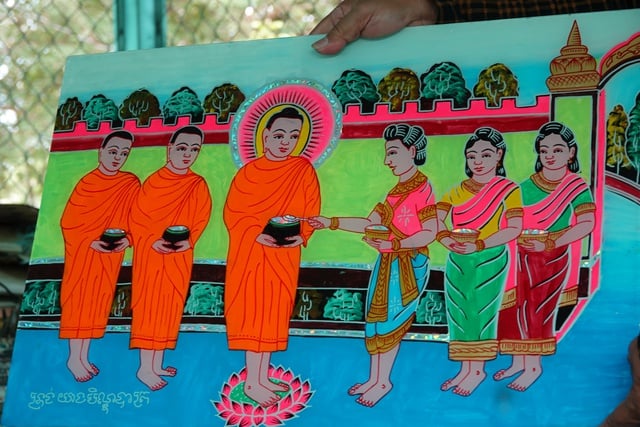
Khmer people's glass paintings mostly have Buddhist themes.
PHOTO: DUY TAN
Khmer glass paintings are painted on the back of a sheet of clear glass, a technique that requires careful and backwards calculation. First, the artist cuts the glass to the desired size, lines it with a sketch paper, then brushes it, applying white, black, and colored paint in the reverse order of a normal painting. A razor blade acts as an “eraser,” used to scrape off any brushstrokes that may have slipped during the painting, bringing out the sharpness of the lines.
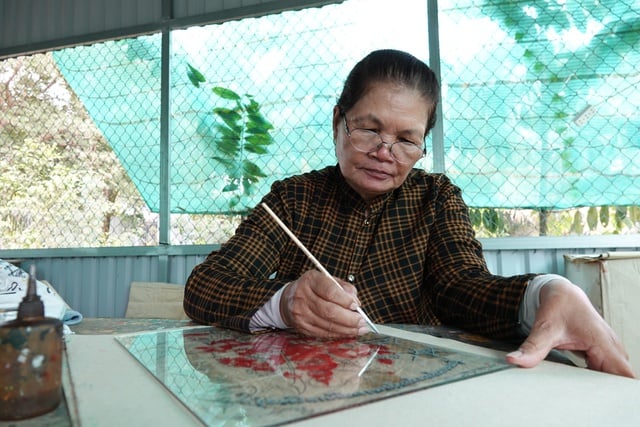
Mrs. Trieu Thi Vui is one of the last artisans still attached to the glass painting profession of the Khmer people.
PHOTO: DUY TAN
Unlike the glass paintings of the Kinh and Chinese people, which often carry religious or folk content, the glass paintings of the Khmer people express the worldview and beliefs of the Southern Buddhism. From images of Buddha, gods to paintings of grandparents and parents, all are shown in a unique style, costume and expression. These details create a line of paintings with a unique identity that is difficult to confuse.
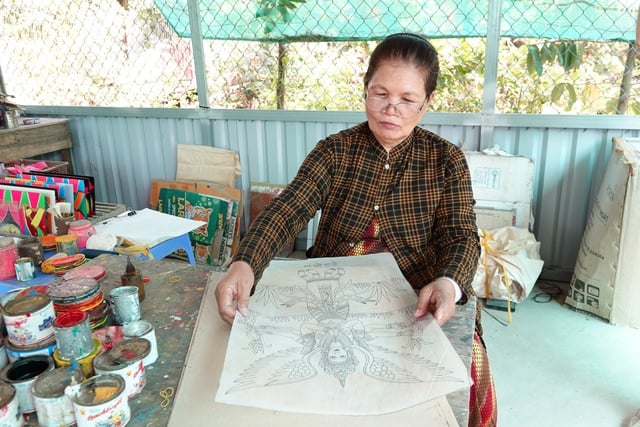
Painting themes are quite diverse, but artists like Mrs. Vui paint most about stories about the life of Buddha.
PHOTO: DUY TAN
Thuan Hoa Commune, Can Tho City (formerly Phu Tan Commune, Chau Thanh District, Soc Trang ) has a large Khmer population. This place is not only famous for its weaving craft but also known as the cradle of Khmer glass painting's quintessence. However, over time, when modern printing technology and many types of industrial paintings took over, the traditional painting craft gradually fell into oblivion. From hundreds of households, now there is only one Mrs. Trieu Thi Vui quietly preserving the old craft.
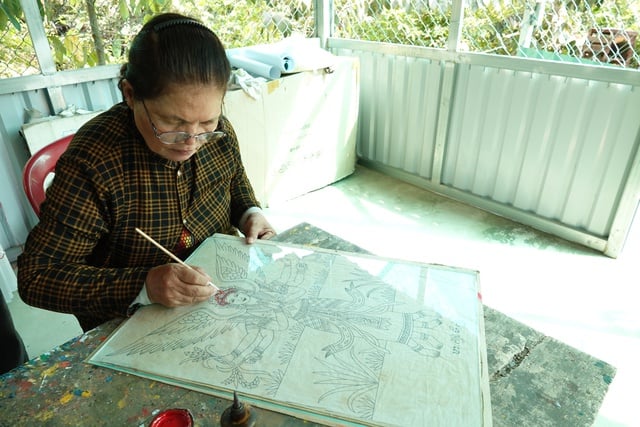
The principle of drawing is from the back of the glass, the last detail is drawn first, when the painting is finished just flip it over and that surface is the surface of the painting.
PHOTO: DUY TAN
Stained glass painting - preserving ancestral cultural values
Mrs. Vui said that even though she can only paint a few dozen paintings each month, for her it is not only a way to make a living but also a way to preserve the cultural values of her ancestors. "In the past, everyone in the neighborhood made glass paintings, the atmosphere was very bustling. Now it is sad, only I am left. But I cannot quit because I love my job and my culture," Mrs. Vui confided.
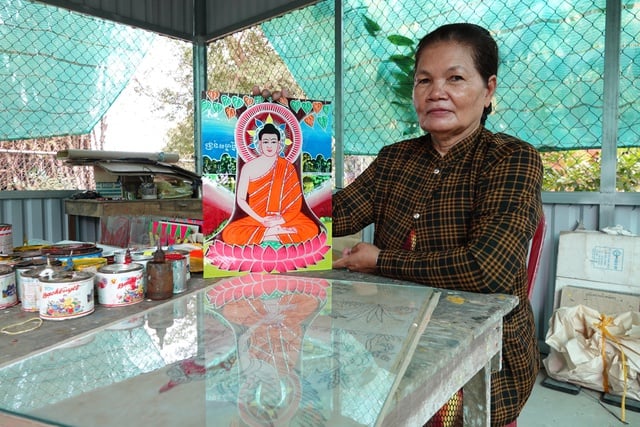
Each glass painting is sold by Mrs. Vui for 200,000 - 400,000 VND.
PHOTO: DUY TAN
With an average income of about 150,000 VND/day, she still has enough to live on and has time to look after her grandchildren. More importantly, glass paintings still play an indispensable role in the spiritual life of many Khmer families, especially in worship and home decoration.
Each painting can take several days to complete, depending on its complexity. "After finishing a layer of paint, you have to dry it in the sun before applying the next layer. This process is repeated several times to get a complete painting," said Ms. Vui.

Even though she can only paint a few dozen pictures each month, for Ms. Vui it is not only a way to make a living but also a way to preserve the cultural values of her ancestors.
PHOTO: DUY TAN
The themes of the paintings are quite diverse, from Buddhist stories, dragon dances, rice spirit goddesses, temple landscapes to famous landmarks. The paintings have vibrant colors, reflecting different aesthetic tastes between regions, such as the color of Buddha's robes or lotus flowers, which also have many variations.
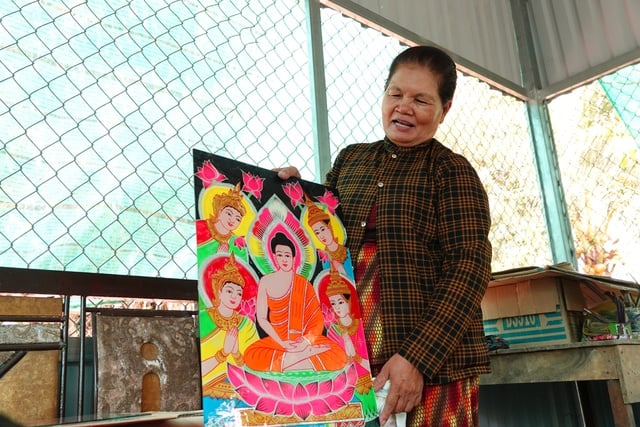
Currently, Ms. Vui's glass paintings are sold for 200,000 - 400,000 VND/piece, depending on size.
PHOTO: DUY TAN
Although it is not difficult to learn, just a few days to be able to hold a brush, a few months to know how to draw lines, the glass painting profession still lacks successors. The reason is because the job requires patience and meticulousness, but the income is not high. "Young people are no longer interested, so I am very worried. If not careful, in a few years this profession will disappear", Mrs. Vui sadly said.
Source: https://thanhnien.vn/niu-giu-nghe-xua-nghe-nhan-cuoi-cung-ve-tranh-kieng-cua-dong-bao-khmer-185250807214319479.htm


![[Photo] Editor-in-Chief of Nhan Dan Newspaper Le Quoc Minh received the working delegation of Pasaxon Newspaper](https://vphoto.vietnam.vn/thumb/1200x675/vietnam/resource/IMAGE/2025/9/23/da79369d8d2849318c3fe8e792f4ce16)


![[Photo] Prime Minister Pham Minh Chinh chairs the 14th meeting of the Steering Committee on IUU](https://vphoto.vietnam.vn/thumb/1200x675/vietnam/resource/IMAGE/2025/9/23/a5244e94b6dd49b3b52bbb92201c6986)





















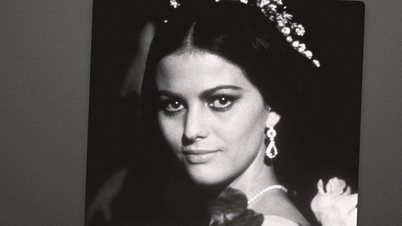









































































Comment (0)